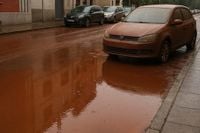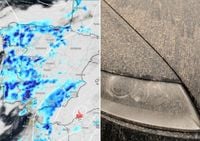As Spain welcomes the beginning of Holy Week, a weather phenomenon known as "blood rain" is expected to take center stage across various regions, driven by the recently formed storm Olivier. This unusual occurrence, characterized by rainfall mixed with suspended particles of Saharan dust, will likely affect several areas from Friday, April 11, 2025, through Sunday, April 13, 2025.
The storm Olivier is set to influence weather patterns significantly, bringing with it a mix of cloud cover and the potential for mud rains, particularly in southern and eastern parts of the Iberian Peninsula, as well as the Balearic Islands. According to the State Meteorological Agency (Aemet), the first signs of this phenomenon will be felt on Friday, with a forecast of cloudy skies and the possibility of isolated precipitation.
On Saturday, April 12, 2025, Aemet warns of a substantial concentration of dust in the atmosphere, leading to rains that could carry mud. This is particularly expected in regions such as Andalusia, the Region of Murcia, the Valencian Community, and parts of Castilla-La Mancha. The agency predicts that temperatures will rise significantly, with some areas experiencing highs exceeding 27 degrees Celsius, especially as warm air masses move in.
By Sunday, April 13, the situation may intensify, as the dust is expected to shift towards the eastern peninsula. The probability of rain accompanied by mud is forecasted at 80% for Tarragona, where the phenomenon could be particularly noticeable. In fact, the probability of mud rain remains high throughout the weekend, with an 80% chance on Monday and a 90% chance on Tuesday.
But what exactly is blood rain? Despite its alarming name, the term refers to a common meteorological event rather than a dangerous phenomenon. Blood rain occurs when rainwater collects dust and sand particles, primarily from the Sahara Desert, during its descent. When these droplets hit light-colored surfaces, they leave behind a reddish or brownish residue, reminiscent of blood, which is why the term has gained popularity in everyday language.
Aemet has noted that blood rain is becoming increasingly common in Spain, especially during spring and autumn when Atlantic weather systems interact with warm air from Africa. This weekend's events mark the convergence of several meteorological factors, including the storm Olivier, which is expected to bring about a notably dynamic weather pattern.
In Mallorca, the storm's effects will also be felt, with forecasts indicating cloudy skies and the potential for blood rain throughout the weekend. The island is expected to see a rise in temperatures, with maximums reaching between 19 and 23 degrees Celsius on Friday. As the weekend progresses, the likelihood of rain, albeit weak and isolated, will increase.
In the southern regions of Galicia, the phenomenon is anticipated to be more pronounced, with blood rain expected to occur on Friday, April 11, following several dry days. Ana Lage from MeteoGalicia explained, "When there are southern winds, dust from the Sahara arrives in the air. It doesn't settle because it's very light. Therefore, if there are precipitation events, that rain comes stained with that dust, turning into brown water, a phenomenon especially visible on darker cars."
As the weekend unfolds, the blood rain will spread across the peninsula, with Aemet predicting that the skies will turn orange in some areas as the rains approach. The phenomenon is expected to reach regions like Andalucía, Extremadura, Castilla-La Mancha, Madrid, and southern Castilla y León by midweek.
While blood rain does not pose a direct health threat, it can have practical implications. It may reduce air quality, particularly in areas with high dust concentrations, and visibility on the roads could be impacted, especially in elevated regions during early morning hours. Furthermore, the dirty residue left on vehicles and outdoor surfaces can be bothersome for residents.
Residents are advised to limit outdoor activities if high levels of suspended particles are detected, particularly those with respiratory issues like asthma. It is also recommended to avoid washing vehicles or windows until the rains have passed.
The weekend's weather is not just about blood rain; it also coincides with a full moon in April and even forecasts of snow in higher altitudes, adding to the meteorological drama of the Holy Week festivities.
As people prepare for the traditional celebrations associated with Holy Week, they will also have to contend with the effects of this unusual weather pattern. With the storm Olivier bringing instability and the possibility of intense showers, it promises to be a weekend filled with both religious observance and weather-related surprises across Spain.
In summary, the arrival of blood rain, driven by the storm Olivier, will paint the skies of Spain in ochre tones this weekend, marking a significant meteorological event as the country steps into Holy Week.






